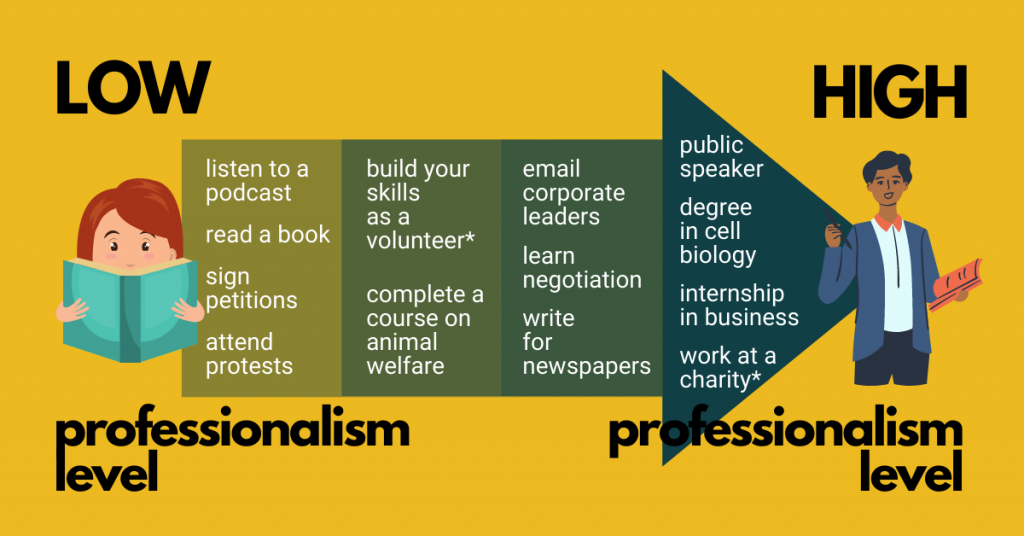
Animal activism: is it (not) for you? Animal advocacy explained.
animal advocacyReading time: 5 minutes
All around the world, animal advocates work tirelessly to help animals. However, sooner or later, they all face the shitty truth: people love eating meat and dairy. Naturally, activists threaten people’s pleasure of eating. This obvious conflict discourages many vegans and keeps them away from the movement. But do they know how helping animals looks like in reality? Is it just about confronting and persuading people?
Let’s imagine that we – vegetarians, vegans, and vegan allies – do our best to help animals. How does it look like? In an ideal situation, we work together, use effective methods, and solve problems creatively. Our work gets a boost from the group synergy, which means that together we achieve more than we would have achieved individually. Luckily, this ideal vision is not far from true. A great number of people work or volunteer in highly effective organizations. They achieve spectacular outcomes and bring us closer to our common goal. But not everyone joins in.
A common misconception: how helping animals looks like in reality?
Even though they also want animal suffering to end, many vegans and vegan allies disapprove and criticize the movement. They stay away from forceful activism, heated debates, and street protests. And while I can perfectly understand their reasons (and even relate to them), the problem seems to be different. Many people don’t know what effective animal advocacy is, and especially, how it can look like in practice.
Animal advocacy stripped down
As an individual, what can you do to help animals? This really depends on what you want to do. In practice, animal advocacy activities differ as much as good-natured Hagrid differs from vicious Malfoy. To show you how many different options there are, I will describe them from four perspectives: the level of exposure, engagement, personal initiative, and professionalism. Of course, these perspectives are completely subjective and you could surely come up with many more ☺ But let’s consider them for a start:
1. Exposure: ferocious duelist or quiet potion-maker?
Activism. What is your first thought when you hear about it? Who are activists, what do they do, and where? Is it a crowd of shouting people covered in blood, holding banners with graphic images? I wouldn’t be surprised if you imagined this. Disruptive, controversial, and vivid events provoke and activate people, which is why the media love showing them. But as usual, what media shows is not the most representative, and many activists are in fact invisible to the public. For example, programmers, graphic designers, or office workers work completely in the background. The same is true for those who sign petitions or help with fundraising. Also, many activities combine quiet background work with a bit of exposure to the public.

2. Engagement: busy Hermione or relaxed Ron?
Animal advocacy – is it about what you do or who you are? Certainly, many people identify themselves with the cause and fill all their free time with animal activism. But animal advocacy is not a life-long sacrifice. Nor is it something you have to do regularly or for some minimum number of hours. Doing effective animal advocacy could mean participating in a conference once a year, listening to a podcast once a month, or donating one additional hour of your work to the most effective charities.

3. Personal initiative: the Order of the Phoenix founder or a hard-working member?
You might think that a true animal activist starts an international organization, launches new campaigns, and coordinates big projects. So maybe it doesn’t make sense to be an activist if you cannot achieve something THAT big? Then you should know that animal advocacy relies on small steps and day-to-day contributions of regular people like you and me. You certainly don’t need to create everything from scratch. Actually, you can be more effective as a part of an existing organization. For example, volunteers in local groups often work on specific tasks assigned by a coordinator. People who like to be more in charge can also do other things – organize a themed dinner for friends or propose new vegan options at a local canteen.

4. Professionalism: Dumbledore expert or promising Neville?
Famous animal advocates write books and revolutionize how people think of animals. So if you are not a Peter Singer, does it mean that you are useless to the movement? Animal advocacy certainly needs skilled professionals. Things change for animals thanks to the hard work of campaign coordinators, researchers, lawyers, marketing managers, fundraisers, and lobbyists. However, these people spend long years (first in training, then gaining experience) to finally end up helping animals. And this is obviously not for everyone. So if not your skills, is there anything else you could contribute? Many simple activities, such as handing out leaflets or organizing vegan potlucks can make a difference. Also, many people don’t realize how complex the animal advocacy movement really is. So learning – through books (e.g., How to Create a Vegan World) or podcasts (e.g., Sentience Institute Podcast) – can be one of the most important things you can do.

So, what are your thoughts? Have you learned about any new animal advocacy activities? Did any activity sound like something you could do? If you like, tell me about this in the comment ☺
Big thanks to Marta Korzeniak from Otwarte Klatki for checking the content of this article! <3
2 comments
Leave a Reply Cancel reply
This site uses Akismet to reduce spam. Learn how your comment data is processed.

Really great article to understand how easy to start activism. All low level tasks are easy to start . Great work
Thank you!!! I’m very glad to hear that it’s helpful 🙂